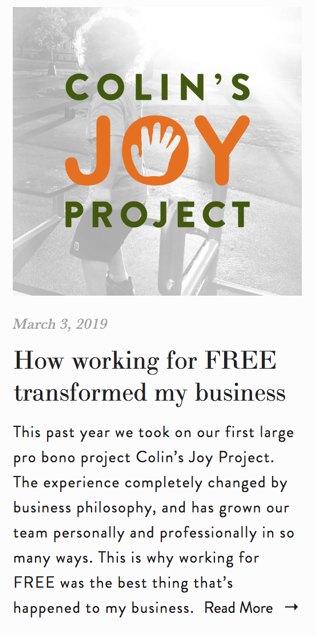If you’re writing post after post for your blog and not getting the shares and the traffic you anticipated, chances are you could be missing some essential elements that help blog posts get noticed. These days everyone has a blog, from the local plumber to the billion dollar makeup company. So how do you get your website to stand out, and people to notice your writing? There’s a pretty basic formula for blog writing that you can use time and time again, and most likely it will be enough to get the attention that your posts need. Just be sure to include all of the following key components every time you write:
-
A compelling title
image 1
The title is your first, and maybe only, chance to get noticed. If you don’t include an engaging titles, people will probably just scroll right on by your post. There is way too much to read on the internet; no one has time to read a boring article. Hence why so many people use click-bait titles. You don’t have to trick people into reading your post, though. Just make sure your title is interesting, and that it also reflects the main purpose of the post. It’s also helpful to convey a sense of urgency- why should someone click on your post and read it right now?
You’ll notice a lot of blog posts are list-based. “X reasons why your business…” or “X things you should be doing…” This is because list-based posts are extremely popular. They’re clear and to the point, and easy for people to follow. But more on that later.
Instead of titling an article “What you need to know about starting a business” try something like “5 things I wish I would have known before starting my own business” or even “What no one tells you about starting your own business”. The latter 2 are both engaging without being spammy, and they make it seem like you need to read this right now if you’re thinking about starting your own business.
-
Purposeful headings
image 2
Headings should be used similar to that of a title. They should be interesting, but also reflect the content listed underneath them. Headings are extremely important if you’re looking to get your blog posts noticed. This is mainly because they:
- Boost SEO
- Try to include keywords in your headings when relevant (don’t just stuff them in there); this will improve your rankings. Headings also make it easy for Google to crawl your content and determine what it’s about, which will also boost your rankings.
- Make it easier for readers navigate text
- It’s much easier for people to understand what a post is about when they’re guided by headings, instead of just trying to navigate large blocks of text
- Save people time/ hold their attention
- Along the same lines, headings help to hold the attention of your audience. It’s easy to get lost in large chunks of text, and many people will get bored or distracted and stop reading. Additionally, if someone wants to read your post but doesn’t have time to get through the whole thing, a heading will help them navigate right to the section they’re interested in.
- Including bullet points is also a good way to help people scan an article
- Additionally, you can emphasize important ideas and headings with bold and italics
-
SEO Optimization
image 3
Use keywords
Before writing any blog post, you should have a keyword strategy in mind. What words are you trying to rank for? Do your homework and come up with a list of words to try to include in your posts. Keywords are what help people find you using search engines, so if you’re not getting noticed by Google or by your target audience, maybe you need to revise your keyword strategy.
Reach out to get backlinks
Backlinks are another way to boost your SEO, and there are things you can do to help your posts get them. Definitely start by writing relevant, valuable posts that people will want to read and link back to, but it doesn’t hurt to go out looking for some additional interest. If you mention a specific product or business in your post, email a link to the company and ask them if they’d feature your post on their website. Or if you wrote about a trending topic, email a few websites that feature similar topics and ask if they’d feature your post on their site. The worst they can do is say “no”!
Share on social media
Share share share your posts all over social media, and encourage others to do the same! Make it easy to share your articles by including social sharing buttons in them. But most of all, write good content that people want to share. Just remember that you’re writing for people, not for Google. Quality writing should also come before SEO (hence no keyword stuffing).
-
A call to action
Whether it’s by leaving a comment, looking at another blog post on your site, checking out a product, etc. you want to encourage your audience to interact with your post. Think about what you want them to take away from the post- what idea should they reflect on? The more a person interacts with a post, the better your rankings will be. Additionally, leaving a comment or sharing a post will help someone remember the central ideas better as opposed to just skimming an article and then forgetting about it 5 minutes later.
-
Internal links
Hopefully you’ve noticed by now that as you read blog posts, chances are you come across multiple hyperlinks within the post. Some of these will be links to other websites to give credit for information, but many of them will be links to other blog posts on the same website. This is because including internal links Increases customer dwell time and the number of pages people visit. And the more pages a person visits, and the longer they spend on your website, the better your rankings will be. Plus, they’re more likely to convert.
-
Engaging photos
“The placement of an image matters. When an image is placed above a headline, the latter ends up being read by 10% more people than when it’s placed below an image. This means you should put your images above your headlines to increase the readership.”
Also, add a caption to each image (with keywords, when applicable). Captions are more likely to be read than the body of the post, so don’t skip on this part!
Check out this article by NoRiskSEO to learn how to take your images to the next level!
-
A quality description
I just ran a site crawl for one of my client’s websites, and the thing they got dinged on the most was that they didn’t write a description for any of their blog posts. So when their article appears on Google, the text underneath is just random sentences from their post that usually don’t even make sense. A meta description is another chance, besides the title, to include keywords and grab the attention of your audience. Keep it short (around 150 characters), but make it compelling. And whatever you do, don’t leave it blank!
-
Quality writing
Your writing reflects your business. If it isn’t professional, then how can someone trust your company? Your articles should be free of grammar and spelling errors; I understand this is difficult for some people who don’t have a background in writing, but use your resources. Spell check exists for a reason. And it never hurts to have other people edit and proofread your writing.
It’s also ok, and even encouraged, to include your personality in your writing. A blog post isn’t a doctoral thesis; if it matches your style and the tone of your company, it’s even ok to cuss a little! (though this isn’t appropriate for everyone; lifestyle bloggers have a lot more freedom than say, medical bloggers). But the point is to let people hear your voice in your writing; you’re not a robot, so don’t sound like one.
The next time you go to write a blog post, check off the elements on this list. What you should end up with is a professional, yet personable, SEO optimized blog post with a great title, headings, captivating photos and internal links. Your audience will be dying to answer your call to action, and your rankings will improve before you know it.
What else should a great blog post include? What are the titles of some of your most successful posts? Comment in the section below!
Image 1: SipDineDesign.com
Image 2: NoRiskSEO.com
Image 3: SipDineDesign.com




